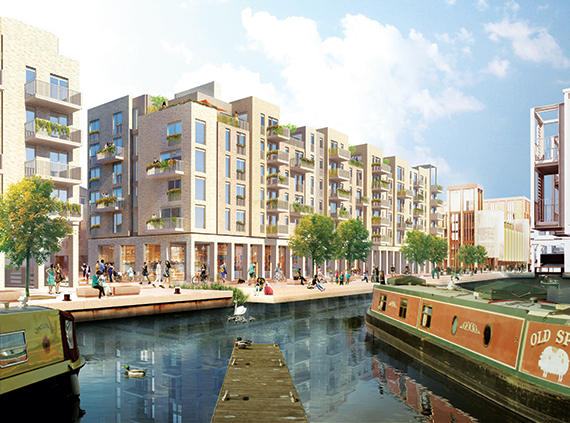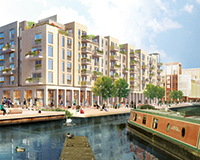 When it comes to Britain’s burgeoning build-to-rent sector and the wider political landscape, one thing is clear: Scotland is different from elsewhere.
When it comes to Britain’s burgeoning build-to-rent sector and the wider political landscape, one thing is clear: Scotland is different from elsewhere.
So while the very substantial interest in Scotland’s private rental sector – especially around Edinburgh – mirrors what is happening south of the border, a set of unique demographics and legislation present very different challenges to institutions and developers.
First, the good news: interest is high.
Grosvenor has consent for up to 400 build-to-rent units at a former industrial site at Fountainbridge near central Edinburgh; opposite this site the EDI Group – a wholly owned subsidiary of Edinburgh council – is seeking detailed consent for 438 units on the old McEwan’s brewery; elsewhere in this part of the capital, Knightsbridge has a further 120 units aimed at long-term student occupation. Meanwhile, at Granton in the north of the city, EDI is starting work on 600 build-to-rent units.
“Edinburgh is by far [Scotland’s] most desirable location with city centre opportunities at the top of everyone’s list,” says CBRE’s senior development director Stewart Taylor.
“Edinburgh has a lot of highly paid graduates in the financial and tech sector who are looking for flexible lease arrangements,” says Lynn Smith, head of development at the EDI Group.
Smith believes Fountainbridge in particular will be key to future schemes in the city with “close proximity to Haymarket station, the expanding Exchange office district, the prime residential area of Bruntsfield, secondary schools being built next door, and its canal-side setting”.
But the rest of the east coast is moving too. LaSalle Investment Managers has invested £600m in a 579-unit scheme near Dyce in Aberdeen, purchased from Dandara: 292 houses and flats are build to rent. Meanwhile in Dundee, developer Whiteburn is transforming a 1960s college building into a modern mixed-use scheme including build to rent.
Combine that with some interest in Glasgow sites – not yet at planning stage – as well as GVA advising the Scottish Cities Alliance on potential schemes in Dundee, Perth and Stirling, and the sector looks in rude health. And, as in England, specification varies site to site.
“The upper end [schemes in Edinburgh] broadly correlates to the private for-sale owner-occupied market,” explains Gerry More, the Scottish Government’s ‘build-to-rent champion’ and head of a working party seeking to unlock barriers to the sector’s growth. So EDI’s offer at Fountainbridge, for example, includes a 5,000 sq ft gym while the design of the houses will emulate the existing Edinburgh vernacular ‘colony style’.
Now the bad news – or at least, less good. This highly optimistic snapshot of institutional interest is being hampered by what some see as unnecessarily complex regulation.
The Scottish Property Federation is particularly exercised by the new Private Housing (Tenancies) (Scotland) Act, taking effect in December 2017.
Although aimed at Scotland’s large and often low-quality buy-to-let sector, the act’s provisions – selective rent controls, restrictions on all non-rent charges, and strict eviction criteria – are very different to those operating in England and Wales.
These controls have created reluctance on the part of build-to-rent investors according to the SPF’s government relations manager, Mandy Catterall. “[The act] may make stabilising a build-to-rent development more difficult. Units let at reduced rates to encourage occupation of a large scheme may be very difficult to bring up to market rents,” warns Catterall. She also fears new eviction criteria could indirectly mean longer voids: “Net operating income could be adversely impacted.”
Not everyone is as pessimistic. Ian Gallacher, planning director at Bilfinger GVA, says the legislation treats tenants as customers, broadly reflecting the build to rent philosophy and, he insists, many investors are undeterred by rent levels tracking inflation, as enshrined in the new act.
“In certain respects, Scotland is leading the UK in trying to integrate build to rent into housing solutions,” he says.
In terms of supply and demand, that optimism appears well placed: what remains to be seen is whether Scotland’s strident regulation allows the sector to blossom.
Aberdeen: bottom of the barrel?
The lettings index from Citylets, a Scottish portal, says the nation’s private rents and demand are both at all-time highs, with one stark exception – Aberdeen.
In that city, rents have fallen 20% in the year to April 2016, are lower now than in 2011, and voids take an average 53 days to let – the longest in Scotland.
Citylets warns the same conditions are likely to prevail for another year at least, thanks to plummeting oil prices.
So what does that mean for build to rent?
Dandara’s 500-unit Stoneywood scheme completes this year.
“The development will be tested severely by the current market. It’ll be interesting to see occupancy levels,” says Michael Groves, regional chief executive of Lomond Capital.
“There are sites in the city centre which have potential for BTR, [but] we anticipate investors will be looking for an improvement in market conditions,” says Derren McRae, head of CBRE Aberdeen.
The irony is that, until recently, Aberdeen’s demand and therefore rents were sky-high – enough to make senior Scottish ministers deem the city a provisional rent control zone in the new Private Housing (Tenancies) (Scotland) Act. That status is now irrelevant, and a lesson in how the market throws public sector regulation and private sector build-to-rent investment alike into disarray.











